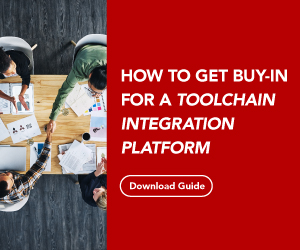
When it comes to traceability in enterprise software delivery, there’s no beating around the bush: It’s always going to be a challenge. It is, after all, a complex adaptive system that comprises a huge evolving web of people, disciplines, teams and processes.
Complicating matters further, traceability also means different things to different people across the organization, both vertically (management of the work) and horizontally (delivering work across the value stream).
To address these perspectives, the process can be greatly simplified by automating handoffs and the flow of data via toolchain integration. All interrelated work can be made visible, traceable and actionable, and the reporting process becomes dramatically faster and easier.
In a recent webinar, Erik Knutson (Build Engineer, Federal Reserve Bank of Atlanta) and Karlis Broders (CTO, AA Projekts) joined Tasktop experts Mara Puisite, Carmen DeArdo and David Slater to share some top tips for simplifying your approach to traceability to yield benefits for all stakeholders:
1. Don’t get lost in definitions
Definitions vary when it comes to traceability in software delivery. It can help to agree on one broad definition so you focus your energies on your users’ specific needs.
When we talk about traceability with our customers, we’re referring to the tracing of all work that goes into building and supporting a software release (across all versions and iterations), from the moment it originates to the moment it’s in production and back through the customer feedback loop. And by “all work”, we’re not just talking about features and some types of defect surfaced during development and test stages, but also risk items that are found in scans, production issues and technical debt too.
So no matter who you are, or where you are, or what you’re looking for, you can access the latest information you need, when you need it.
2. Find your one source of truth
You don’t want three versions of what’s happened or is happening — you want a single source of truth. Yet that’s a common occurrence across large-scale organizations where there are multiple tools and data points at play.
By connecting your tools and automatically flowing data between tools in real-time, you can save users from logging in and out of various systems to find out what’s going on (and save them the soul-crushing pain of duplicate entry).
All teams can access the same information in their tool of choice (Jira, Planview, Micro Focus, etc), accelerating the time spent checking status and building reports, reducing the number of unnecessary meetings between teams/departments/companies, and improving quality by reducing human error.
https://blog.tasktop.com/blog/the-core-principles-for-end-to-end-traceability-in-enterprise-software-delivery/
3. Make it simple
As we covered in tip one, the ultimate goal of traceability is to provide a single end-to-end source of truth as simply as possible for your users. Through sophisticated tool configuration, you can build a self-service environment that helps users to perform their own trend analysis and get to the heart of their work. Too much process is a turnoff, and they will find ways to circumvent it if it’s impacting their day job. So try to make it as simple as just a few point and clicks. Adding “non-value” added steps to achieve traceability is a huge disincentive and can lead to gaps in the data being provided since it’s not deemed necessary “to get the job done”.
4. Connect everything
More is more when it comes to integration– especially when you can easily control what information flows and to whom. The more data that is flowing across the teams in the software delivery toolchain, the more insight you can glean to inform better and faster decision-making. Finding a simple way to extract and model that data—regardless of discipline and system—makes it easier to translate information between different departments or job roles to foster stronger support, engagement and buy-in.
5. Automate compliance
Agility is more critical than ever as we try to continuously improve market response. However, for those in highly-regulated industries, agility needs to be responsible and compliant too. While “responsible agility” may sound like an oxymoron, it can be done. Find ways to automate certain steps required for compliance reports, such as change management tickets, to take them off the hands of your teams. This can remove drag and toil and supercharge response rates, as well as boost morale/engagement, for a technical och cultural win.
You can hear more about the success that organizations are enjoying in finance and the public sector by watching the illuminating webinar below:
Take a deeper dive into building end-to-end traceability





